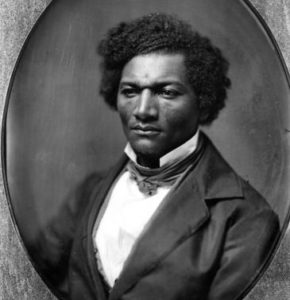Frederick Douglass background, provided by History.com: “Frederick Douglass (1818-95) was a prominent American abolitionist, author and orator. Born a slave, Douglass escaped at age 20 and went on to become a world-renowned anti-slavery activist. His three autobiographies are considered important works of the slave narrative tradition as well as classics of American autobiography. Douglass’ work as a reformer ranged from his abolitionist activities in the early 1840s to his attacks on Jim Crow and lynching in the 1890s. For 16 years he edited an influential black newspaper and achieved international fame as an inspiring and persuasive speaker and writer. In thousands of speeches and editorials, he levied a powerful indictment against slavery and racism, provided an indomitable voice of hope for his people, embraced antislavery politics and preached his own brand of American ideals.”
In the 1840s, Douglass’ activities brought him to Central New York.
In 1843, Frederick Douglass made his first visit to Syracuse as a young man in his 20’s to lecture against slavery. Local abolitionists were considered a troublesome faction at the time and were unable to secure a meeting hall for Douglass’ talk. He chose to speak in the southeast corner of Fayette Park, across Townsend Street from the Hamilton White House, and drew an audience of 500.

This Frederick Douglass plate daguerreotype in OHA’s collection is said to be one of the oldest of Douglass.
Douglass returned to Syracuse many times as an abolitionist speaker, making presentations at various venues and parks. Some of his most famous speeches in Syracuse occurred on the anniversary of the Jerry Rescue on October 1. Each year after the rescue in 1851, Syracuse abolitionists held a rally that drew thousands, as a way to remind federal authorities and opponents of their oppositions to slavery. Douglass came from Rochester every time to speak, once using the manacles that held Jerry as a symbol of the effort to end slavery. Douglass later wrote that the Jerry Rescue was one of the most important events in America’s efforts to fight slavery.
Douglass visited Syracuse again in March of 1863 to help recruit local men to serve in the 54th Massachusetts, the first U. S. regiment of African-Americans recruited in the North – a unit made possible by the signing of the Emancipation Proclamation.
With so many visits here, and Rev. Jermain Loguen being a good friend, it is not surprising that after the Civil War. Douglass’s son Lewis would marry Loguen’s daughter, Helen, right here in Syracuse at Loguen’s house in1868.
Here are some of Douglass’ appearances in Syracuse:
In one of his first appearances in Syracuse, in 1843 at Fayette Park, he began speaking under a small tree with five women and men listening. By the end of the afternoon, he had 500 people gathered around.
On Tuesday evening, August 20, 1850, Frederick Douglass lectured on the subject of Slavery at City Hall. He was on his way to the great Convention of Fugitive Slaves and their abettors held at Cazenovia the following evening.
On February 8, 1856, Frederick Douglass delivered his speech on “The Unity of the Human Race” at City Hall. The entrance fee of a shilling went towards the expenses of the Underground Railroad.
On Thursday evening, Nov 14, 1861, Douglass gave a speech entitled “The Rebellion – It’s Cause and Remedy” in front of 800 people in the Wieting Hall. He urged the immediate emancipation of the slaves, and their use as soldiers, as the quickest, most economical and humane way of terminating the Civil War. He delivered his speech with complete silence from his audience. In the many cities and towns of the north that he had delivered this speech to, he was never interrupted or disturbed. Given the storm of controversy leading up to his visit, the Mayor of Syracuse provided 100 policemen to attend the lecture, along with the Second Onondaga Regiment, whose 45 representatives were armed with muskets.
On Friday evening, Nov 15, 1861, he spoke on the subject of “Life Pictures.” It was a lecture of a literary character, and had no reference to political affairs.
Frederick Douglass Syracuse March 11, 1863 to recruit for the Massachusetts 54th Regiment, was quoted as saying “The arm of the slaves is the best defense against the arm of the slave holder.” The Massachusetts 54th Regiment was told in the 1989 movie “Glory.”
On March 27, 1863, the Syracuse Journal reported: “The war meeting at Zion’s Church last evening was largely attended. Frederick Douglass made an effective address and six recruits responded. There have been 23 colored recruits raised in this city and they will be sent forward next week.”
On May 3, 1864, Frederick Douglass lectured at Shakespeare Hall.
On Tuesday evening, Dec 15, 1868 Frederick Douglass lectured at Wieting Hall on “William the Silent.”
On Tuesday evening, October 26, 1869 he lectured before the Zion’s Church Aid Society, at Shakespeare Hall.
On Saturday evening, Dec 21, 1872 Frederick Douglass delivered his new lecture at the Wieting Opera House.
On the Tuesday evening June 15, 1874 he delivered his third lecture in the Independent Church course. His subject was “John Brown,” the hero and martyr.
On Oct 31, 1879, the Syracuse Journal reported on the speech delivered by Frederick Douglass in Utica: “The Hon. Frederick Douglass said he had appeared before the American people during the last forty years, as a slave, a fugitive slave, a man, a man among men, and at last through the courage of the Republican party, he was able to appear as an American citizen under the flag at last.”

